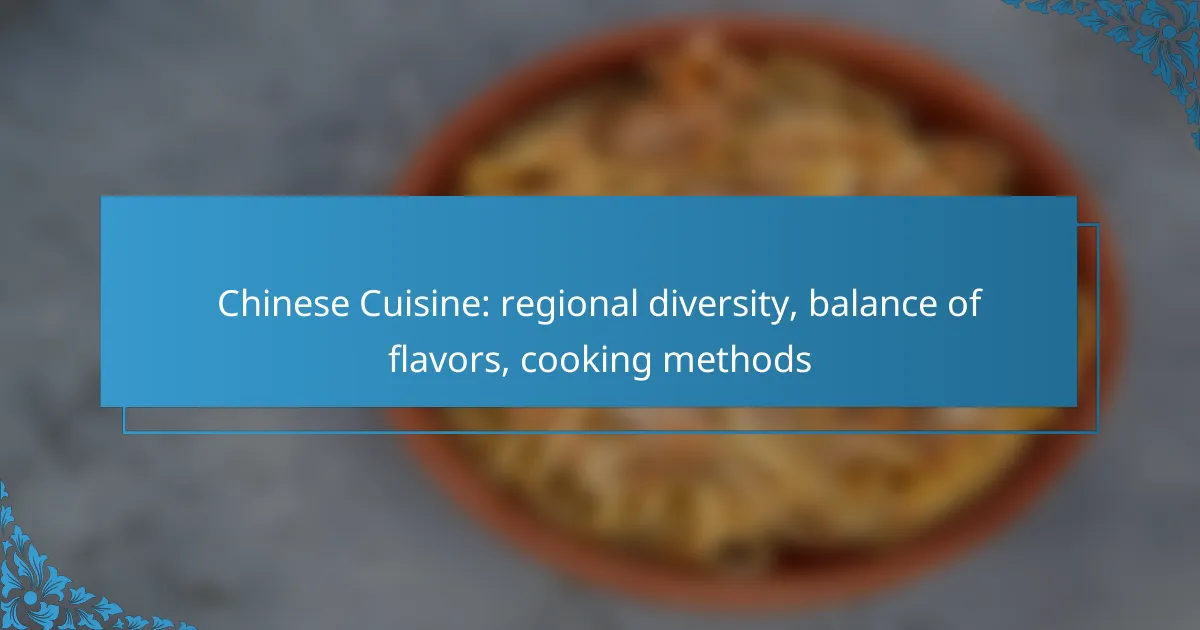Chinese cuisine is renowned for its regional diversity, with each area presenting a unique blend of ingredients, flavors, and cooking techniques. The harmonious balance of five fundamental tastes, influenced by the principles of yin and yang, creates a rich and complex culinary experience. Various cooking methods, such as stir-frying, steaming, and deep-frying, further enhance the flavors and textures of the dishes, making Chinese food a vibrant and dynamic aspect of culinary art.

What are the key regional styles of Chinese cuisine?
Chinese cuisine is characterized by its regional diversity, with each area showcasing unique ingredients, flavors, and cooking methods. The key regional styles include Cantonese, Sichuan, Shandong, Huaiyang, and Xinjiang, each offering distinct culinary experiences.
Cantonese cuisine
Cantonese cuisine, originating from Guangdong province, is known for its emphasis on fresh ingredients and subtle flavors. Dishes often feature stir-frying, steaming, and braising techniques, allowing the natural taste of the ingredients to shine.
Popular dishes include dim sum, roasted meats, and seafood, often served with light sauces. The use of herbs and spices is moderate, focusing on enhancing rather than overpowering the main flavors.
Sichuan cuisine
Sichuan cuisine is famous for its bold flavors, particularly the use of Sichuan peppercorns and chili peppers, which create a unique numbing and spicy sensation. This style often incorporates techniques like stir-frying, steaming, and braising, but with a focus on layering flavors.
Signature dishes include Kung Pao chicken and mapo tofu, which highlight the balance of heat and flavor. Diners should be prepared for a vibrant and intense culinary experience.
Shandong cuisine
Shandong cuisine, one of the oldest regional styles, is recognized for its emphasis on seafood and the use of vinegar and garlic. The cooking methods include braising, frying, and steaming, which help to preserve the freshness of the ingredients.
Notable dishes include sweet and sour carp and various soups. This cuisine often features a balance of flavors, with a focus on umami and freshness, making it a staple in northern China.
Huaiyang cuisine
Huaiyang cuisine is celebrated for its meticulous preparation and presentation, often using techniques like braising and stewing. Originating from the Huai River and Yangtze River regions, it emphasizes seasonal ingredients and delicate flavors.
Signature dishes include Yangzhou fried rice and braised pork, showcasing a balance of sweetness and saltiness. The emphasis on aesthetics makes Huaiyang cuisine particularly appealing for special occasions.
Xinjiang cuisine
Xinjiang cuisine reflects the diverse cultural influences of the region, particularly from Central Asia. It is known for its hearty dishes, often featuring lamb, beef, and a variety of spices, including cumin and chili.
Common dishes include lamb skewers and pilaf, which are typically cooked over open flames or in tandoors. The cuisine is characterized by bold flavors and a focus on communal dining, making it a unique culinary experience in China.

How do flavors balance in Chinese dishes?
Flavors in Chinese dishes balance through a harmonious combination of five fundamental tastes, the principles of yin and yang, and various seasoning techniques. This intricate balance creates a rich culinary experience that is both satisfying and complex.
Five fundamental flavors
The five fundamental flavors in Chinese cuisine are sweet, sour, salty, bitter, and umami. Each flavor plays a crucial role in achieving balance within a dish. For example, sweet and sour combinations are common in dishes like sweet and sour pork, where the contrasting tastes enhance the overall flavor profile.
Understanding how to combine these flavors is essential for creating authentic Chinese dishes. A good rule of thumb is to ensure that no single flavor dominates; instead, they should complement each other to achieve a well-rounded taste.
Importance of yin and yang
The concept of yin and yang is central to Chinese cooking, representing balance and harmony. Yin flavors are typically cool and refreshing, such as cucumbers and tofu, while yang flavors are warm and stimulating, like ginger and garlic. A well-balanced dish often incorporates both elements to create a satisfying meal.
When preparing a dish, consider the yin and yang of the ingredients. For instance, pairing a spicy stir-fry (yang) with a cooling side of pickled vegetables (yin) can enhance the overall dining experience.
Seasoning techniques
Seasoning techniques in Chinese cuisine vary widely and are essential for flavor balance. Common methods include marinating, stir-frying, and using sauces like soy sauce, oyster sauce, and vinegar. Each technique brings out different aspects of the ingredients and contributes to the dish’s overall flavor.
When seasoning, start with small amounts and adjust according to taste. A common pitfall is over-seasoning, which can overwhelm the dish. Instead, aim for subtlety, allowing the natural flavors of the ingredients to shine through while enhancing them with appropriate seasonings.

What are the common cooking methods in Chinese cuisine?
Chinese cuisine employs a variety of cooking methods that enhance flavors and textures. The most common techniques include stir-frying, steaming, deep-frying, and boiling, each offering unique advantages and suitable for different types of ingredients.
Stir-frying
Stir-frying is a quick cooking method that involves cooking food over high heat in a small amount of oil while continuously stirring. This technique preserves the color, texture, and nutrients of the ingredients, making it ideal for vegetables and thinly sliced meats.
To achieve the best results, use a wok for even heat distribution and ensure all ingredients are prepped before cooking. Common stir-fry dishes include beef with broccoli and chicken with cashews.
Steaming
Steaming is a gentle cooking method that retains moisture and nutrients, making it a healthy option. This technique involves placing food above boiling water in a steamer, allowing steam to cook the food evenly.
Dim sum and fish fillets are popular steamed dishes. For optimal results, ensure the water does not touch the food and use a lid to trap steam effectively.
Deep-frying
Deep-frying involves submerging food in hot oil, creating a crispy exterior while keeping the interior moist. This method is often used for dishes like spring rolls and crispy fried chicken.
To deep-fry successfully, maintain the oil temperature between 350°F and 375°F (about 175°C to 190°C) to prevent sogginess. Use a thermometer for accuracy and avoid overcrowding the pan to ensure even cooking.
Boiling
Boiling is a straightforward method where food is cooked in water or broth at high temperatures. This technique is commonly used for noodles, dumplings, and soups.
When boiling, add salt to the water to enhance flavor and consider the cooking time for different ingredients to avoid overcooking. Quick boiling times for noodles typically range from 3 to 5 minutes, while dumplings may take about 8 to 10 minutes.

What ingredients are essential in Chinese cooking?
Essential ingredients in Chinese cooking include rice, noodles, a variety of vegetables, meats, seafood, and an array of herbs and spices. These components create the diverse flavors and textures characteristic of Chinese cuisine, allowing for a balance of taste and nutrition.
Rice and noodles
Rice is a staple in many regions of China, serving as a primary carbohydrate source. It can be steamed, fried, or used in soups, with varieties like jasmine and sticky rice being popular. Noodles, made from wheat or rice, come in various shapes and sizes, such as egg noodles and rice vermicelli, and are often stir-fried or served in broth.
When cooking rice, a common ratio is one part rice to about one and a half parts water, though this can vary based on the type of rice. For noodles, cooking times typically range from a few minutes to around ten, depending on the thickness and type.
Vegetables and herbs
Vegetables play a crucial role in Chinese cooking, providing essential nutrients and vibrant colors. Common choices include bok choy, Chinese broccoli, and bell peppers, which can be stir-fried, steamed, or used in soups. Fresh herbs like cilantro and green onions add aromatic flavors and are often used as garnishes.
When selecting vegetables, aim for seasonal produce for the best flavor and freshness. A quick tip is to cut vegetables into uniform sizes to ensure even cooking, enhancing both texture and presentation.
Meats and seafood
Meats such as pork, chicken, and beef are frequently used in Chinese dishes, often marinated to enhance flavor. Seafood, including fish, shrimp, and scallops, is also popular, particularly in coastal regions. Cooking methods vary from stir-frying and steaming to braising, each imparting distinct flavors.
For meats, marinating for at least 30 minutes can significantly improve taste, while seafood should be cooked quickly to maintain tenderness. A common practice is to use a combination of soy sauce, ginger, and garlic in marinades for a classic flavor profile.

How does regional diversity influence local Chinese restaurants?
Regional diversity significantly shapes local Chinese restaurants by dictating their menu offerings, ingredient choices, and cooking methods. Each region of China has its own culinary traditions, which are reflected in the dishes served, creating a rich tapestry of flavors and techniques across the country.
Menu variations
Menu variations in Chinese restaurants are largely influenced by regional specialties. For instance, Sichuan restaurants often feature spicy dishes with bold flavors, while Cantonese cuisine emphasizes freshness and subtlety. Diners can expect to find unique dishes like Peking duck in Beijing or dim sum in Guangdong, showcasing the local culinary heritage.
When exploring menu options, consider that many restaurants may offer a fusion of styles, blending elements from different regions. This can lead to innovative dishes that reflect the chef’s personal touch, but it may also dilute traditional flavors.
Ingredient sourcing
Ingredient sourcing is crucial in defining the authenticity of a Chinese restaurant’s offerings. Restaurants often source local produce, meats, and seafood to ensure freshness and quality. For example, coastal regions may prioritize seafood, while inland areas might focus on grains and vegetables.
Additionally, some restaurants may import specialty ingredients from China to maintain traditional flavors. This can include sauces, spices, and unique vegetables that are not readily available in local markets, impacting both cost and authenticity.
Cooking techniques
Cooking techniques vary widely across Chinese cuisine and are influenced by regional practices. For example, stir-frying is common in Cantonese cooking, while steaming is prevalent in the Jiangsu region. These methods not only affect the taste and texture of the food but also the overall dining experience.
Understanding these techniques can help diners appreciate the craftsmanship behind each dish. When dining out, look for restaurants that highlight traditional methods, as this often indicates a commitment to authenticity and quality in their culinary offerings.

What are the health benefits of traditional Chinese cuisine?
Traditional Chinese cuisine offers numerous health benefits, primarily due to its emphasis on balance, variety, and the use of fresh ingredients. This culinary tradition promotes a holistic approach to eating, which can enhance overall well-being and prevent chronic diseases.
Balance of flavors
The balance of flavors in traditional Chinese cuisine—sweet, sour, bitter, spicy, and salty—contributes to its health benefits. Each flavor is believed to correspond with different health properties and can aid in digestion, boost immunity, and promote energy levels. For example, bitter flavors, often found in greens like bitter melon, can help detoxify the body.
Incorporating a variety of flavors in meals ensures a wide range of nutrients, which is essential for maintaining health. This approach encourages the consumption of diverse ingredients, including vegetables, grains, and proteins, leading to a more balanced diet.
Cooking methods
Traditional Chinese cooking methods, such as steaming, stir-frying, and braising, are generally healthier than deep-frying. Steaming preserves nutrients and flavors without adding unnecessary fats, while stir-frying uses minimal oil and cooks food quickly, retaining its nutritional value. These methods help maintain the integrity of ingredients, ensuring that meals are both nutritious and flavorful.
When preparing Chinese dishes, consider using techniques that enhance health benefits. For instance, incorporating more vegetables and lean proteins while reducing the use of heavy sauces can create lighter, healthier meals. Aim for a colorful plate, as this often indicates a variety of nutrients.
Use of herbs and spices
Herbs and spices play a crucial role in traditional Chinese cuisine, not just for flavor but also for their medicinal properties. Ingredients like ginger, garlic, and scallions are commonly used for their anti-inflammatory and immune-boosting effects. Incorporating these elements into meals can enhance both taste and health.
To maximize health benefits, consider adding herbs and spices to your cooking regularly. For example, using turmeric in stir-fries can provide anti-inflammatory benefits, while adding chili peppers can boost metabolism. Experimenting with different combinations can lead to delicious and healthful meals.
